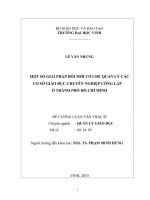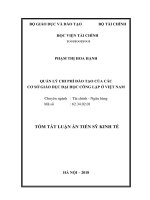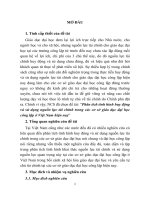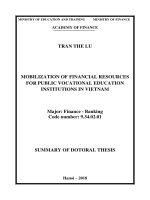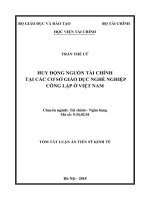Huy động nguồn tài chính tại các cơ sở giáo dục nghề nghiệp công lập ở việt nam tom tat tieng anh
Bạn đang xem bản rút gọn của tài liệu. Xem và tải ngay bản đầy đủ của tài liệu tại đây (415.36 KB, 27 trang )
MINISTRY OF EDUCATION AND TRAINING
MINISTRY OF FINANCE
ACADEMY OF FINANCE
TRAN THE LU
MOBILIZATION OF FINANCIAL RESOURCES
FOR PUBLIC VOCATIONAL EDUCATION
INSTITUTIONS IN VIETNAM
Major: Finance - Banking
Code number: 9.34.02.01
SUMMARY OF DOTORAL THESIS
Hanoi – 2018
THE WORK WAS COMPLETED
AT ACADEMY OF FINANCE
Scientific instructor: ASS. PROF. PHD. DUONG DANG CHINH
Opponent 1:……………………………………………………...
…..………………………………………………….
Opponent 2: ……………………………………………………...
……………………………………………………..
Opponent 3: ……………………………………………………...
………………………………………………………
The thesis will be defended in front of the thesis marking Council at
State level held at Academy of Finance, Hanoi
At…..h….day…..month….year 2018
It is possible to learn about at the thesis in National Library and Library
of Academy of Finance
PREFACE
1. Necessary of theme
Improving the quality of human resources and concentrating on the
development of high-quality personnel force are always required by each
country and each economy. Vocational education is one of the methods to
train human resources to meet the requirements of the economy in the
context of international economic integration. The goal of vocational
education is to make a clear change in the quality and effectiveness of
vocational education to meet the needs of learners, the labor market and
enterprises, especially some sectors that require technical and high
technology for the Fourth Industrial Revolution.
Nowadays, Vietnamese public vocational education institutions are
facing with many challenges. The state budget per student has dropped
dramatically which creats the risk of reducing the quality of training and
forces the public vocational education institutions to mobilize more
external financial resources by other ways such as increasing tuition fees,
establishing strong joint ventures, enhancing the direct or indirect support
for learners, reducing the opportuinities for young people to to access
many forms of vocational training then leading to the unfair in the field of
education. In addition, in order to increase the sources of revenue, the
vocational education institutions need to open more short-term and longterm training forms and etc, scientific research contracts to meet the
learning requirements of the society.
In recent years, the government has paid much attention to the field
of vocational education, especially the promulgation of many financial
mechanisms to facilitate vocational education institutions to improve the
quality of training and expand the training scale. The vocational
education institutions have continously renewed themselves, enhanced
prestige and reputation, improved the curriculum to meet the learning
1
needs of the society and found opportunities to associate with domestic or
foreign patners to improve the quality and supply of human resources for
society. However, financial resources have not yet met the demands of
the vocational education institutions and they need to improve the
mechanism to mobilize financial resources, especially financial resources
outside the state budget.
On the basis of inheriting research results of previously published
works and theoretical and practical issues that have not been clarified on
the mobilization of financial resources for vocational education
institutions, to solve the remaining problems of previous studies, the PhD
student selected the topic “Mobilization of financial resources for public
vocational education institutions in Vietnam” to do a economic
disertation.
2. Research purpose
General purpose
The thesis establishs a scientific and practical basis and propose
solutions to mobilize financial resources for public vocational education
institutions in Vietnam.
Research duties
- Systematizing and clarifying the theoretical issues on mobilizing
financial resources for vocational education institutions.
- Analyzing and evaluating the practice of mobilizing financial
resources for public vocational education institutions in Vietnam.
- Innovating solutions to mobilize financial resources for public
vocational education institutions in Vietnam.
3. Object and scope of the research
Research object: The scientific and practical issues on the
mobilization of financial resources for public vocational education
institutions in Vietnam.
2
Scope of research
- Contents: To study the issue of mobilizing financial sources,
including state budget sources and non-state budget sources in public
vocational education institutions.
- Space: To be limited to public vocational education institutions
and send 400 questionnaires to students enrolled in 10 vocational
colleges and 5 vocational schools in the public vocational education
system of Vietnam. The thesis selects vocational colleges and
vocational schools.
- Time: Data collected from 2006 to 2017, the proposal solutions for
the period from 2018 to 2022, the vision to 2030.
4. Research method
4.1. Approching methodology
To achieve the purpose, scope and objective of the research, the PhD
student used the methodology of dialectical materialism and historical
materialism throughout the research process.
4.2. Research methodology
In the research process, the dissertation is based on the combination
of qualitative and quantitative research on the mobilization of financial
resources for educational institutions in general and for vocational
education institutions in particular. This method is also used to analyze
the impact of mechanisms of mobilization of financial resources to
enhancing the financial management of vocational education institutions
as well as subjective factors and objective factors which affect the
mobilization of financial resources for vocational education institutions.
Quantitative methods are used to describe the specific results of
mechanisms of mobilization of financial resources in public vocational
education institutions, in each mobilization channel used through the
results of sampling survey in several typical institutions.
3
5. The scientific and practical contribution of the thesis
- The dissertation clarifies the basic theoretical issues of mobilizing
financial resources at public vocational education institutions, provides
the views on mobilizing financial resources at public vocational
education institutions, analyzes and identifies the factors influencing the
mobilization of financial resources at public vocational education
institutions. Moreover, the thesis mentions international experiences on
mobilizing financial resources at public vocational education institutions
and draws some lessons for Vietnam.
- The thesis analyzes and evaluates the situation of mobilizing
financial resources at public vocational education institutions in Vietnam
in terms of economic environment; the legal framework for mobilizing
financial resources at public vocational education institutions; explains the
limitations of mobilizing financial resources at public vocational education
institutions in Vietnam in the past period in accordance with the contents
given in Chapter 1. In addition to assessing the situation on a qualitative
basis, PhD Student also uses quantitative methods to study the factors
affecting the desires of learners participated in public vocational education
institutions; as well as give some solutions on
funding for public
vocational education institutions in Vietnam in the near future.
- The thesis proposes two groups of measures to mobilize financial
resources for public vocational education institutions in Vietnam in the
coming time: (i) the group of solutions to reform state budget for vocational
education to ensure the effective usage of financial sources from the state
budget, focusing on the renovation of the mechanism of allocating and
assigning state budget estimatation to vocational education institutions in
association with important sectors and fields of the nation (ii) the group of
solutions to mobilize financial resources from non-state budget, mainly
focusing on improving policies on tution fees, service charges and
4
supporting students to access to credit, and it is necessary to review the
reform of the financial management mechanism in the field of public
vocational education; improving the mechanism of self-control and
socialization development in the field of public vocational education in
Vietnam in the future.
6. Content of the thesis
With the research purpose and scope as mentioned above, apart from
the preface, conclusion, references, appendix, the thesis includes 3
chapters:
Chapter 1: Argument on mobilization of financial resources for
public vocational education institutions
Chapter 2: Mobilization of financial resources for public vocational
education instutions in vietnam
Chapter 3: Solution for mobilization of financial resources for public
vocational education institutions in vietnam
CHAPTER 1
ARGUMENT ON MOBILIZATION OF FINANCIAL RESOURCES
FOR PUBLIC VOCATIONAL EDUCATION INSTITUTIONS
1.1. Vocational education and vocational education system
1.1.1. The concept of vocational education
So far, the issue of vocational education has been paid attention by
managers and scientists, and there are many different approaches.
According to the research, the thesis indicates that: Vocational
education is a level of the national education system to provide
vocational primary, secondary, college and other training to labor to meet
the demand of human resources directly in production, business and
services and it is conducted in two forms: formal training and regular
training.
5
1.1.2. Characteristics of vocational education
- Vocational education is not purely public service;
- Vocational education is always linked to the requirements of the
labor market and economic and social development strategies in each
stage of development of the country;
- International economic integration is indispensable trend and there
are requirements for vocational education;
- Vocational education refers to those who work directly in business
organizations.
1.1.3. The role of vocational education in the economic and social
development of a country
- Vocational education contributes to economic growth;
- Vocational education is the basement to improve the quality of
human resources;
- Vocational education creates job opportunities, increases incomes,
alleviates poverty and contributes to build an equal society among
population classes.
1.1.4. Vocational education system
Vocational education system includes:
- Primary level;
- Secondary level;
- College level.
1.2. Mobilization of financial resources for public vocational
education institutions
1.2.1. Financial resources and mobilization of financial resources
1.2.1.1. Financial resources
Financial resources are the amount of current capital in the form of
currency and being converted to currency has been mobilized to serve the
socio-economic development of a country. In a broad sense, financial
6
resources are the allocation of economic relations that arise from these
sources of finance. In a narrow sense, referring to financial sources refers
to sources of capital. These funds come from the state budget, private
sectors, foreign investment, investment funds, trust funds and etc.
1.2.1.2. Mobilization of financil resources
Refering to mobilizing financial resources at public vocational
education institutions, it includes the incentive for the value of the wealth
of the state, domestic and foreign organizations, individuals and
enterprises investing in public vocational education institutions and the
aspect of exploiting existing wealth values of them.
1.2.2. The content of mobilization of financial resources for
public vocational education institutions
With the financial resources from the state budget: For vocational
education institutions, self-financing is the source of the owner's equity
from the beginning of it or initial capital contribution. In the field of
vocational education, self-financing comes from the state budget, formed
from public investment, through public revenues (the Government's
Budget).
In order to improve the quality of vocational education, the
insttitutions in the vocational education sector need to have financial
resources from other sources such as: Financial resources from the nonstate budget at public vocational education institutions are usually formed
by the following sources:
- Tution fee;
- Revenues from training services;
- Contribution of organizations, enterprises and individuals;
- Financial sources from credit institutions and individuals
borrowing from banks, investment funds;
- Foreign capital.
7
1.2.3. The channels for mobilizing financial resources in public
vocational education institutions
1.2.3.1. Mobilizing financial resources from state budget
The financial resources allocated by the government to vocational
education are considered as a fund for the purchase of training products,
research products, purchase of knowledge transfer and technology
transfer services, or for the provision of training services.
1.2.3.2. Mobilizing financial resources from non-state budget
- Mobilizing financial resources from tution fee: The vocational
education fee provided by public vocational education institutions is
subject to the following main factors: (i) expenses for formulation and
provision of services; (ii) the level of financial accumulation needed; (iv)
government regulation; (v) international integration;
- Mobilizing financial resources from associated training;
- Mobilizing financial resources from intermediary financial
institutions;
- Mobilizing financial resources from other funds (contributed or
supported by domestic or foreign organizations, enterprises and
individuals).
1.3. Factors affecting the mobilization of financial resources in
public vocational education institutions
1.3.1. The objective factors
- Trend in economic restructuring;
- The fluctuation in economic cycle;
- Integration, opening up the economy;
- The view of society and the State's policy on vocational education;
- Science and technology;
- Labor market
8
1.3.2. The subjective factors
Subjective factors are the internal factors of each vocational
education institutions. These factors directly affect the activities of them,
including:
- Human resources, quality and structure of human resources;
- The facilities and use of them in service of vocational education
activities;
- Management of vocational education activities at vocational
education institutions;
- The usage of financial resources at vocational education
institutions.
1.4. Research model of factors affecting the desirability of
trainees who participate in the vocational education institutions
Whether students and families want to take vocational courses or not
is also the answer to questions regarding enrollment and mobilization of
financial resources because tuition fee is still the most important source of
funding with vocational education institutions. Therefore, the study of the
factors affecting the desire to study in the vocational education
institutions may give important suggestions on the following issues:
- Evaluating the quality of education;
- Determining the tution fee;
- Developing credit products to support the apprenticeship process,
thereby creating more funding for vocational education institutions.
Based on the above reason, PhD student conducted research on the
factors affecting the trainee's desire to learn.
According to the results of previous studies, the thesis studied the
factors influencing the mobilization of financial resources in public
vocational education institutions by the trainees' apprenticeship with the
following hypotheses:
9
- H1: The learner's educational level has the opposite effect on the
learner's desire to take vocational course;
- H2: The benefits of vocational education have a positive impact on
learners' appetite for learning;
- H3: Access to credit has a positive impact on the learner's desire to
learn;
- H4: Supportive policies have a positive impact on learners' desire
for apprenticeship.
The multiple regression equation for the proposed research model is
as follows:
Y=ß0 + ß1HV + ß2LI + ß3TD + ß4HT
In which:
-
Y: The feeling of desire to learn the job
-
HV: Academic level
-
LI: The benefit from vocational education training
-
TD: Accessibility to credit
-
T: Supporting student policy
1.5. Experience in mobilizing financial resources in vocational
education institutions in some countries and lessons for Vietnam
The thesis has studied the experiences of some countries such as USA,
Germany, Japan, Korea, Singapore and Malaysia.
- American experience: In America, the state budget for vocational
education is focused, but they are continously renewing the methods to
invest in vocational education by state budget.
- German experience: In general, the development of education and
training, including the vocational education in Germany, is guided by a
cross-cutting view that "Only those who are educated and trained well
will help Germany to take the lead in the global race as well as be be best
part in that development.
10
- Japanese experience: The post-secondary system consists of
universities, colleges, technical colleges as well as specialized training
schools that directly train human resources for the country.
- South Korean experience: The Government considers human
resource training as a priority in education to ensure that human resources
meet the requirements of industrialization. Education is carried out in
parallel with the industrialization process.
- Experience from Singapore: The government believes that success
in the race for educational and religious development will create the
success in the race for economic development. So, from the XXI century,
the government has spent 3-5% of its GDP on education and training, and
now accounts for about 10% of GDP.
- Malaysia's experience: Malaysia is one of the countries with the
best economic development in Southeast Asia and they have such
economic achievements because Malaysia is interested in investing in
human resources.
From that, draw some lessons for Vietnam as follows:
- Firstly, the allocation of state budget according to results of
activities for vocational education institutions;
- Secondly, socialization of financial resources for vocational
education institutions by training at companies and enterprises.
- Thirdly, linking the mobilization and usage of financial resources
with the planning of the system of vocational education. 2.
11
CHAPTER 2
MOBILIZATION OF FINANCIAL RESOURCES FOR PUBLIC
VOCATIONAL EDUCATION INSTUTIONS IN VIETNAM
2.1. Overview of public vocational education in Vietnam
2.1.1. Achievement
The results of practial implementation of legal documents have
made initial changes in the quality of vocational training, in particular:
- Firstly, the formation of a unified system of vocational education
operating under the provisions of the Law on vocational education;
- Secondly, the enrollment in 2017 has made positive changes,
reaching the target;
- Thirdly, more and more models of high quality training institutions
appear;
- Fourthly, the awareness of the people and society on vocational
education has made positive changes.
2.1.2. Drawbacks in vocational education
- The effectiveness of vocational education is limited;
- The quality of vocational education is not high;
- Socialization of vocational education is limited.
2.2. Real situation of mobilization of financial resources for
public vocational education institutions
2.2.1. Mobilization of financial resources for public vocational
education institutions
2.2.1.1. Expenditures for public vocational education from state
budget
In the structure of expenditures for vocational education from the
state budget, priority has been given to remote areas, disadvantaged areas,
border areas, islands and ethnic minority areas, reflecting the distribution
coefficient.
12
State budget expenditure for the vocational education system as compared
to the total state budget expenditures
Year
State budget
expenditure
for the
vocational
education
(billion VND)
Compared
with GDP
(%)
Compared
with total
state budget
(%)
Compared
with total
state budget
for education
and training
(%)
2006
3.673
0,38
1,24
6,7
2007
4.443
0,39
1,36
7,15
2008
5.585
0,41
1,47
7,35
2009
6.670
0,45
1,5
7,5
2010
8.811
0,46
1,45
8,53
2011
9.800
0,45
1,63
8,16
2012
10.746
0,47
1,55
8.08
2013
11.784
0,46
1,21
8,15
2014
14.308
0,53
1,42
8,2
2015
16.453
0,57
1,43
8,33
2016
15.884
0,54
1,25
8,12
2017
15.312
0,51
1,19
7,96
Sources: Ministry of Labor, Invalids and Social Affairs (2017)
2.2.1.2. Mobilizing financial resources from state budget for
vocational education
In the period of 2006 - 2017, the state budget for public vocational
education shall be mainly focused on beneficiaries of social welfare,
investing in areas, regions which have not been capable of socialization
of vocational education yet, investing in national key occupations and etc.
At the same time, the mode of allocation of the state budget has also
changed fundamentally from the allocation of input cost factors to the
13
mode of allocation associated with the mechanism of assignment from
governmental management units.
2.2.2. Mobilizing financial resouces from non-state budget
2.2.2.1. Overview of mobilizing financial resources from non-state
budget
Financial resources from non –state budget
Unity: Billion VND; %
Year
NonContributed
state
by learners
budge
(tution fee)
t
Revenues
from
services,
business
operation
Domestic
investment
and funding
Foreign
investment
and funding
2006
789
387 49,0
73
9,25
75
9,51
254
32,19
2007
1.021
496 49,0
86
8,42
99
9,70
340
33,30
2008
1.067
593 56,0
95
8,90
119
11,15
260
24,37
2009
1.103
693 63,0
104
9,43
139
12,60
167
15,14
2010
1.789
1.242 69,0
114
6,37
155
8,66
278
15,54
2011
1.801
1.256 70,0
126
7,00
126
7,00
293
16,27
2012
1.726
1.293 75,0
139
8,05
129
7,47
165
9,56
2013
1.997
1.549 78,0
152
7,61
155
7,76
141
7,06
2014
2.339
1.678 72,0
168
7,18
168
7,18
325
13,89
2015
2.549
1.831 72,0
190
7,45
192
7,53
336
13,18
2016
2.823
1.989 70,0
225
7,97
228
8,08
381
13,50
2017
3.557
2.506 70,0
290
8,16
294
8,27
466
13,11
Total
22.561 15.513
1.762
1.879
3.406
Sources: Ministry of Labor, Invalids and Social Affairs (2017)
2.2.2.2. Mobilization of financial resources from tution fee
The annual tution fee of public vocational education institutions
depends on two factors: (i) policy on tuition fees by sector, region of the
14
government; (ii) implementation of enrollment criteria by sector and
regions of them.
- Firstly, the quality of teachers and managers in public vocational
education institutions;
- Secondly, the quality of training program is in accordance with the
tution fee;
- Thirdly, the facilities and teaching equipment.
2.2.2.3.Mobilization of financial resources from association and
service provision
The revenue generated from business activities, associated training
and service provision of public vocational education institutions in the
past 12 years accounted for only 7.74% of total non-state revenues.
2.2.2.4.Mobilization of financial resources from investment,
supporting of domestic and foreign organizations, individuals
In order to receive funding from investment, financial support from
domestic and foreign organizations and individuals and enterprises,
excluding to the measures to enhance prestige and trademark as
mentioned above, propaganda measures , promoting the activities of
vocational training and promoting association in training are important
measures for the public institutions.
- Firstly, for measures to propagate and promote the activities of
vocational education;
- Secondly, cooperation, funding between public vocational
education institutions and organizations and individuals
2.2.3. The result of study research on factors that affect the
desirability to take vocational education of students
2.2.3.1. Sampling and data colection
306 of valid samples are collected and computed using SPSS,
version 22 software.
15
2.2.3.2. Analysis of data
The collected data were verified by the reliability test Cronbach
alpha and EFA analysis. After that, multivariate regression analysis was
used to test the hypothesis. The result of research on factors that affect the
desirability to take vocational education of students is summarized as
follow:
Y = 1.091 – 0.460 HV + 0.078 LI + 0.183 TD + 0.174 HT
In which:
▪ HV: Education level
▪ LI: The benefit of vocational education
▪ TD: Student loan accessibility
▪ HT: Student support policy
The regression equation shows that the coefficient ß1 is less than 0
(demonstrates the inverse relationship between the independent variable
and the desired perceiving vocational education), other standardized ß
coefficients are greater than 0 (demonstrating the positive relationship
between independent variables and the desired perceiving vocational
education). So all hypotheses are backed by set of research data.
2.3. Evaluating the situation of mobilizing financial resources
at public vocational education institutions in Vietnam
2.3.1. Archivement on mobilizing financial resources at public
vocational education institutions in Vietnam
Firstly, based on legal documents implemented by the State, public
vocational education institutions in Vietnam have mobilized a certain
amount of financial resources for the development strategy of vocational
education.
Secondly, the quality of training at public vocational education
institutions in Vietnam was improved in order to have appropriate tuition
fees.
16
Thirdly, Financial resources socialization proportion at public
vocational education institutions in Vietnam was improved.
2.3.2. Limitations
- Public vocational education institutions in Vietnam is still mostly
depend on State budget.
- Financial source from the service of Public vocational education
institutions in Vietnam has been used at the best rate in non-state budget,
however, The proportion is not match with the income of Vietnamese
people.
- Public vocational education institutions in Vietnam have not had
solution to extend the non-state budget financial source by training
association activities.
- Proportion of Financial source from student loan and sponsored
scholarship is still under target.
- Financial management for vocational education and financial
mobilization does not meet requirement.
2.3.3. Explaination
2.3.3.1. Objective reasons
Firstly, awareness of position and role of vocational education in the
socio-economic development process is still limited. The propaganda
activities is not focused properly.
Secondly, the system of mechanisms and policies of the State for
vocational education has been paid great attention by the State, however,
it is not consistent with other policies.
Thirdly, the determination to promote and develop vocational
education is not properly focused. Vocational education is not considered
as a decisive factor in creating high quality human resources for
economic growth.
17
2.3.3.2. Subjective reasons
- The implementation of financial autonomy and self-responsibility
in some public vocational education institutions in Vietnam is not
effective.
- Solutions
for
socialization
of
vocational
education
and
socialization of financial investment to develop vocational education
mainly focus on the developed area.
- Public vocational education institutions in Vietnam did not pay
appropriate attention in the contents, measures and forms of propagation
and dissemination of their bussiness.
- There are not enough effective solutions in implementation of
autonomy finance mechanism, especially the mobilization of non-state
budget finance resource.
CHAPTER 3
SOLUTION FOR MOBILIZATION OF FINANCIAL
RESOURCES FOR PUBLIC VOCATIONAL EDUCATION
INSTITUTIONS IN VIETNAM
3.1. Development target on vocational education in Vietnam by
2025 and vision toward 2030
By the year of 2020, vocational education in Vietnam should be able
to meet the demand of the labor market in terms of quantity, quality,
occupational structure and the quality of training standard of some
developed countries in the ASEAN region and the world
3.2. Perspective on mobilizing financial resources for public
vocational education institutions in Vietnam
- Firstly, considering financial investment in vocational education is
a kind of development investments.
18
- Secondly, considering the capital from the State budget as
"beginning capital" to promote and support other non-state budget for
vocational education.
- Thirdly, completing solution for mobilize financial sources by
increasing the proportion of non-state budget sources for public
vocational education institutions in Vietnam.
- Fourthly, putting together mobilization with the use and effective
management of financial sources at public vocational education
institutions in Vietnam.
- Fifthly, thoroughly resolving the principle of equality, and
transparency in solution for mobilization of financial resources for public
vocational education institutions in Vietnam
3.3. Solution for mobilization of financial resources for public
vocational education institutions in vietnam
3.3.1. Renovating state budget expenditures for vocational
education so as to ensure the efficient use of financial sources from
the state budget
- Firstly, Renewing the mechanism of allocating and assigning state
budget estimates to public vocational education institutions in association
with important branches and domains of the economy. To restructure the
system of public vocational education, to ensure the effectiveness of the
management of vocational education activities in public institutions, to
enhance the result of the socialization purpose in education, especially
socializing the financial sources for investment in activities of enrolling
and expanding the autonomy and self-responsibility in the activities of
public vocational education institutions.
- Secondly, Completing and renewing the policy on scholarship and
social policies. The reform of the financial allocation mechanism
following the direction as : Institutionalization and publicization of the
19
reform of the process of financial allocation of investment for the field of
vocational education. To complete the system of financial allocation
norms for the appropriate field of vocational education and to increase the
powers attached to the financial autonomy of budget spending units and
public resources.
- Thirdly, The state budget for investment in vocational education
development should be implemented under the program of vocational
education development.
- Fouth, Examining, monitoring and improving the efficiency of
state budget for vocational education.
3.3.2. Solutions for mobilization of non-state budget financial
sources
* Completing policies on service charges and fees.
To revise, analyze and re-evaluate the current policy on service
charges and fees in the field of vocational education applied for to public
institutions, thus consider the positive aspects, shortcomings and
drawbacks of service price policy. To take a survey and re-assess in
details the expenditure on the average expenditure per student and
calculate the tuition fee to cover the cost of vocational training for a pupil
at each educational level.
* Supporting students to access credit capital.
Student credit is long-term credits, as students need credit during
their studies and can not afford to pay in the short term. These credits can
be paid only after the student has graduated and earned a living. The
borrower's fair repayment is of great significance to the Student Credit
Scheme, to ensure the re-creation of funds to maintain the operations of
credit institutions. In countries where it is difficult to find jobs, especially
for low-income jobs, it is difficult to deduct a portion of income to repay
20
credit institutions. In this context, the customer morality in repaying
credit will greatly affect the credit relationship.
Credit scheme for students to use the resources of the State to
provide preferential credit for students in difficult circumstances to get
loans for study, to help the student not to drop out of school due to their
inability to pay tuition and cover their minimum living needs. At the
same time, to create opportunities for disadvantaged students to continue
their study path, contributing to the training of human resources with high
qualifications for the country. Especially students who are studying at
public vocational education institutions in Vietnam.
* Increasing income from business and service activities in public
vocational education institutions in Vietnam
The current status of facilities in public vocational education
institutions in Vietnam is needed to be reviewed and evaluated for
establishing policies and supporting investments in the school system in
order to improve the quality of education services, products which has
high quality and can be commercialized. In additional, To review land
policies, tax policies, preferential credit policies... is needed to be
reviewed and revised in order to encourage investment and development
of public vocational education institutions in Vietnam.
Develop the policy to make use of the existing facilities to create the
necessary products which can be socialized to increase the school
income. Obviously, in order to be able to make use of the material
facilities and equipment of the school to make products which can be
socialized, vocational education institutions in Vietnam have to study
consumer demand, product marketing, on the other hand, they need to
review the capacity of human resources, equipment, the production
process to create products for the market.
21
* Attracting of investment, donations from organizations and
individuals for vocational education.
- Attracting investment, sponsorship of local organizations and
individuals.
- Expanding investment attraction, funding of foreign organizations
and individuals.
- Developping mechanisms to attract revenue from enterprises and
users of vocational education.
Private sector participation need to be considered in vocational
education, such as: public-private dialogue, their contributions to training
program and financial contributions. The role of professional associations
and enterprises in management of vocational education must be
strengthen to take advantages of their experience of the region and the
context of Vietnamese market to formulate vocational training programs
in line with the contents of international economic standard.
- Increasing revenues from associated training services
- Encourage individuals and organizations to donate charity for the
development of vocational education.
3.4. Conditions for solutions
3.4.1. Reviewing the reform of the financial management
mechanism in the field of vocational education
Financial regulations on vocational education in the most relevant
legal documents such as the Law on Vocational education, the Law on
the State Budget... need to be revised and amended. The Law on
vocational education should have specific regulations on investment in
vocational education development in line with the nature and
characteristics of vocational education. The law on the State Budget
should have specific regulations on the roles and responsibilities of
central and local state management agencies in the process of
22
formulation, consolidation and allowcation of state budget for vocational
education.
3.4.2. Completing the mechanism of autonomy, development of
socialization in the field of vocational education
- Arranging the state budget and mobilizing non-State budget
resources to promote the socialization of public services in the field of
vocational education.
- Promotting international cooperation to increase
financial
resources for vocational education.
- Developping the market of public services in the field of
vocational education.
- Strengthening the supervision, inspection and handling of
violations in the socialization of public services in the field of vocational
education.
CONCLUSION
The contents and results of the thesis have focused on the
following issues:
- Analysing of scientific arguments shows the need to deploy and
increase the mobilization of financial resources, especially non-state
budget for public vocational education institutions in Vietnam.
- In the context of international economic integration, public
vocational education institutions in Vietnam play a key role, contributing
to the provision of highly qualified workers.
- Analyzing and approving on the concept, content and method of
mobilizing financial sources, especially non-state budget for public
vocational education institutions in Vietnam.
- Analyzing the situation of mobilizing financial resources for public
vocational education institutions in Vietnam to clarify the archivement,
23

